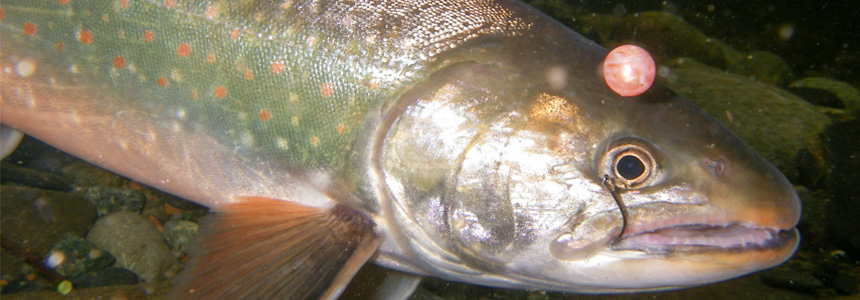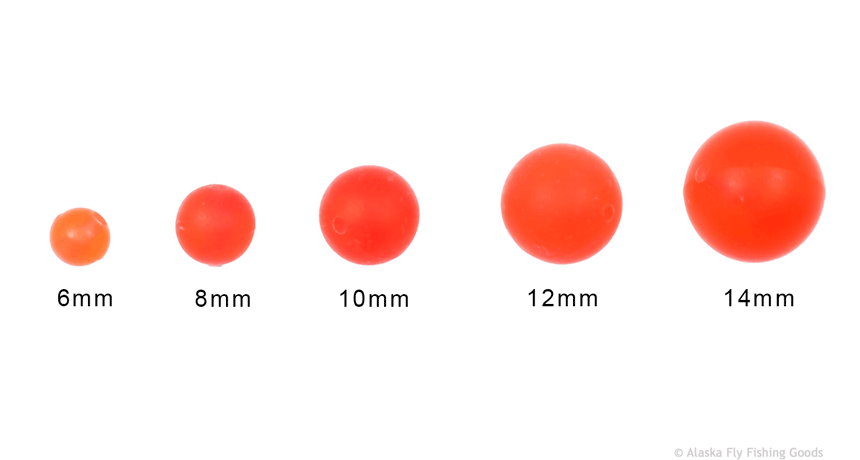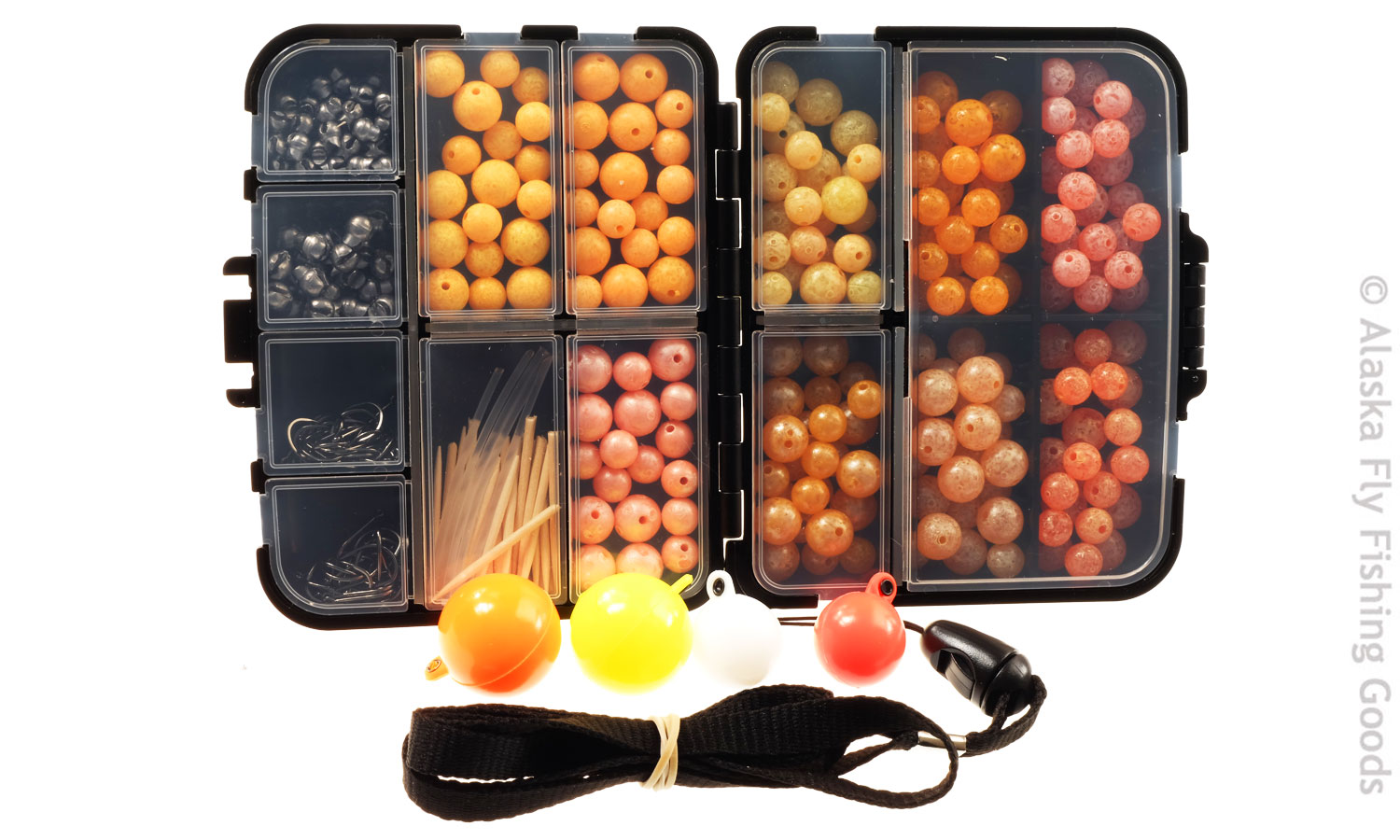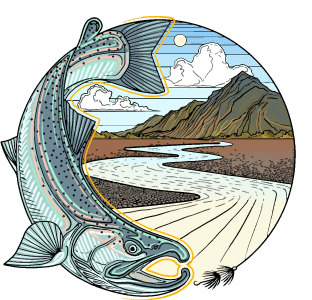 Dolly Varden on the bead. Photo by Mark Hieronymus.
Dolly Varden on the bead. Photo by Mark Hieronymus.
Have you found yourself wondering why grown men and women spend their free time painting plastic beads? Lurking in fly shop aisles looking for just the right color tone? Elbowing teenage girls out of the way to purchase various shades of nail polish? Standing mid-stream, mumbling to themselves, while staring intently into their enormous selection of beads? Why do they go to all this trouble when they could just use a glo bug?
Because beads work!
Honing in on the perfect color bead is Alaska's way of matching the hatch of mayflies, caddis, or stoneflies on a trout river. Beads can better match the eggs drifting out of salmon or trout redds during a spawn. A bead drifting down the river looks so much like a real salmon egg that trout and char often can't tell the difference. And chances are, underwater, you couldn't either.
Beads have quickly grown to be one of the most popular ways to catch trout behind spawning salmon. This isn't to say that beads are the only egg pattern that will work in Alaska; old standby flies such as glo bugs still have a time and a place. If you are fishing rainbows or Dollies at the height of the spawn or in a heavily fished area, beads are the way to go. We can help you choose your beads, rig them up right, and fish them effectively.
CHOOSING THE CORRECT BEAD
A little research can really help you prepare for your next trip in Alaska. Here are a few tips to help you choose the beads needed to make a successful trip.

When determining what size bead to throw first, there are a couple of things to note. First, the run timing of the river or stream you are on, and second, what salmon is spawning in the area.
Run timing plays a major factor in determining what beads to use. Different species of salmon spawn at different times, and particular run timing can differ from year to year depending upon what Mother Nature has in store. To be safe, check fishing reports for the area you are planning to fish, being aware of how things are going will help you show up with the right beads.
Determining what species of salmon spawn in the area you plan to visit is critical to your day of fishing. The different species of salmon have different sized roe, or eggs. Sockeye (Red) salmon produce the smallest roe. Typically a 6mm bead is used to imitate the sockeye egg. Pink (Humpy) and Coho (Silver) roe are medium size. Start with an 8mm bead if these fish are spawning. Chum (Dog) and King (Chinook) salmon produce the largest eggs. An 8mm or 10mm bead is a good size for these salmon. You can easily find beads in 6mm, 8mm, 10mm and even 12mm which means that there is a bead for any situation.
Another rule of thumb is to fish smaller beads in slower water where fish have more time to inspect the bead, and fish larger beads in faster water and chutes where the bead is going to drift by the fish at a faster rate. In those situations a larger target for the trout to key in on is better.
 Full Bristol Bay bead selection, made custom by Alaska Fly Fishing Goods.Bead Color
Full Bristol Bay bead selection, made custom by Alaska Fly Fishing Goods.Bead Color
When beginning your day on the water, it is important to understand that eggs change in appearance after they are laid. An egg that has just come out of a salmon is said to be a “fresh” or “live” egg. It will often be orange and have an oily sheen to it. After the egg has been in the water for some time and is free floating it will appear as mottled light pink or peach. An egg can also become a “dead egg” and have a darker more solid appearance. Try looking around in side pools or along the river bottom to see what the eggs look like.
If you still don’t know which eggs the trout are feeding on, a good rule of thumb is to start with a live egg bead. Some good live egg colors from the Troutbeads brand include Natural Roe, Dark Roe and Tangerine. If live eggs don't do the trick try mimicking an older egg. The Mottled Beads Series from Troutbeads are very effective at creating the look of an egg that has been out of the spawning bed for a while and is free floating. These are a favorite target of trout. It is also important to carry a good selection of dead egg colors like Dark Peach and Apricot. These beads can be deadly, especially late in the spawn.

Leader rigged with all the fixings.
HOW TO MAKE A BEAD RIG
There are several ways to make bead rigs with different styles of leaders. Most anglers use a strike indicator such as Thing-a-Mabobbers or Airlocks but this is not mandatory. How you choose to fish is up to you. A typical leader is 4-7 ft of straight 8, 10, or 12 lb. monofilament (usually Maxima Ultragreen) and about 2 feet of 8-10 lb. fluorocarbon tippet, Sunline FC Sniper is our fluorocarbon of choice. The idea behind this simple two-part leader is to get the leader to hang vertically in the water column. This reduces drag on the leader and leads to a drag-free drift. Standard 7 ½ - 9 ft tapered leaders can also be used. Tie on an easily adjustable indicator so that you can change depths quickly. If split shot is needed attach it to the leader at the tippet connection. Hooks should be stout short shanks in size 4, 6, or 8 to match bead size and fish size. For more info on bead rigs, check out our article Bead Fishing 201: The Next Level.
ATTACHING THE BEAD
There are a variety of pegs on the market for bead fishing these days. Ranging from tapered silicone pegs, monofilament pegs, or toothpick pegs, here is a loose example of how to set your bead in place, using a peg of your choice.
Slide the bead onto the leader and attach the hook using your preferred clinch or trilene knot. Slide the bead within 2 inches of the hook. Insert your chosen peg into the bead facing away from the hook. Use a twisting motion to help lock the bead into place on the leader. Next, nip the peg as close to the hook as possible. Be cautious not to fray the leader and not to crack or chip the bead.
Another method to attach your bead to your leader uses the bead knot. The bead knot is fast and easy because it doesn’t require pegging the bead. The down-side is that the leader weakens more quickly. First, slide the bead through the leader like you would if you were to peg it. Now, run the leader through the bead the same way a second time so that the bead is attached to the leader via a loop. Next, slide the bead up the leader so that you can attach the hook. Once the hook is attached, slide the bead back down the leader towards the hook. Once you have the bead in place, open the loop up by pushing the leader through the bead towards the hook. Once the loop opens on the outer side of the bead, take the hook and wrap it through the loop 8-10 times like you would a clinch knot. Now pull tight. If done correctly the knot will snug up into the bead with none of it exposed.
HOW TO FISH A BEAD
Bead fishing techniques are very similar to nymphing techniques. In the most common scenario you cast 45 degrees upstream from the fish that you are targeting, get a good up stream mend and dead drift the bead. Trout key in on eggs that are dislodged from spawning beds and are drifting down the river. Often there is a lot of food in the river during the salmon spawn, so trout can be picky about the presentation and selection of beads. At the same time, don’t be surprised if a trout charges 5 feet or more to grab a bead. If you’re sight fishing to a particular fish and it doesn’t eat the first bead you throw at it, take your time and try a different bead color or a different size. Chances are you will be able to get that fish to bite.
Rods matter when it comes to bead fishing. Unlike saltwater applications where you are trying to cast long distances, often into wind, a rod for nymphing beads is going to have a lot more feel. 9', 9'6", and even 10' rods with a softer flex profile will allow you to control drifts more effectively and are roll casting machines. The Sage Sonic, Sage R8 Core, and Echo One Hand Spey are some of our favorite bead rods here at Alaska Fly Fishing Goods.
 Underwater shot of a hungry Dolly Varden trout. Photo by Mark Hieronymus.
Underwater shot of a hungry Dolly Varden trout. Photo by Mark Hieronymus.
FINAL NOTES
In the State of Alaska beads are considered attractors, not flies.
When fishing beads in Alaska’s fresh waters, a bead that is fixed or “pegged” so that it cannot freely slide on the leader, cannot be fixed more than 2 inches from the hook.
While beads are not considered flies, you cannot fish them in fly-fishing only waters with a bare hook. In fly-fishing only waters a fly tied of traditional means (with thread) must be used with beads. A thread wrapped hook with a pegged bead will suffice in fly-fishing only waters under state regulations.
Please check with the Alaska Department of Fish and Game for further information.





What hook would you recommend when fishing 6mm beads for trout?
Hi Alex,
Sorry for the late reply. This is one that slipped by us and we apologize. Typically a hook like Gamakatsu C14Ss in a size 8 (6 if the fish are big) is a good way to go. The C14s is a straight eye so it can be attached with a standard fishing knot or improved clinch. Some guys like using up eyed octopus style hooks in which you would use a knot called a snell. This knot is attached to the hook shank rather than the eye which leaves the leader perfectly inline with the hook shank. Same hook sizing works with this method. Hope that this is helpful.
Tight Lines